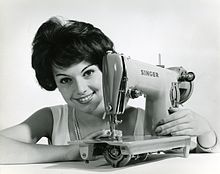Singer (company)
| The Singer Company
|
|
|---|---|
| legal form | |
| founding | 1851 as IM Singer & Co. |
| Seat | La Vergne, Tennessee |
| Website | www.singer.com |
The Singer Company was founded in 1851 as IM Singer & Company by entrepreneur and inventor Isaac Merritt Singer and New York attorney Edward Clark . Within a very short time the company rose to become the largest sewing machine manufacturer in the world.
history


Isaac Merritt Singer, who had previously developed a rock drill and a machine for wood and metalworking, worked in Orson C. Phelps' Boston workshop in 1850 . It was here that Lerow and Blodgett's sewing machines were built, and he subsequently worked on improving them. On August 12, 1851, he received a patent for the improved sewing machine. Elias Howe , who received a patent for a sewing machine on September 10, 1846, involved Singer in a lengthy patent litigation because he used a Howe component in his sewing machine. Singer's lawyer was Edward Clark, with whom he founded IM Singer & Company in 1851 .
The company developed into the leading sewing machine manufacturer in the USA within two years. In 1853 it was renamed the Singer Manufacturing Company . In the same year, a new corporate administration and new manufacturing facilities were built in New York City. Just two years later, the Singer sewing machine won first prize at the World Exhibition in Paris in 1855 . At the same time, the Singer Manufacturing Company rose to become the world's largest sewing machine factory. Edward Clark developed the installment purchase plan in 1856, the prototype for installment sales .
In 1863 the Singer Manufacturing Company held 22 patents and had capital of $ 555,000. In addition to offices in Hamburg ( Singer Sewing Machines AG .), Scotland (Singer Manufacturing Company Ltd) and Brazil (Singer Do Brasil Ind. E Com. Ltda.), The main company headquarters and three factories were established in New York City . Annual production rose to 20,000 sewing machines. In 1867 the first Singer factory outside the USA was built in Glasgow (Bridgton), Scotland . Further production facilities followed in Montreal , Canada , in Floridsdorf in Austria and various locations in the USA. In 1880 the annual production was 500,000 sewing machines. The factory, which opened in Kilbowie , Scotland, in 1883 , employed 12,000 workers alone. The Singer Manufacturing Company developed the first working electric sewing machine in 1889. Further innovative developments were the first portable sewing machine in 1921 and the first computer-controlled sewing machine in 1978.
As early as 1890, the Singer Company had a world market share of 80 percent. Further important international manufacturing branches were established in Podolsk , Russia in 1902 , in Saint Petersburg in 1904 (there the company had its Art Nouveau company building, still known today as the Singer House, built on the avenue Nevsky Prospect ), in 1904 the sewing machine factory in Wittenberge and Saint John in Canada, in 1933 in Monza, Italy and Bonnières-sur-Seine in France and in 1955 in Campinas, Brazil . As early as 1913, worldwide sales reached the annual production figure of 3 million pieces.
The Singer Building , built in Manhattan in 1908, was one of the first skyscrapers and for a short time the tallest building in the world. The company was headquartered here for 54 years before moving to Rockefeller Center. In 1929, the year of the Great Depression, Singer took over the Standard Sewing Machine Company. In the same year the first Singer vacuum cleaner came onto the market.
The company name was changed to The Singer Company in 1963 . In the following years, Singer took over several electronics and office machine companies, such as Friden, Inc. (known at the time for the first fully transistorized desktop computers ), Packard Bell (a brand name still used today for electronic products) and General Precision Equipment as well as Kearfott (active in the armaments sector) . In the early 1970s, the company had 120,000 employees worldwide and annual sales of $ 2.5 billion. Today, the Singer company, like the Husqvarna Viking company, belongs to the SVP Worldwide company in Hamilton , Bermuda .




